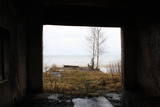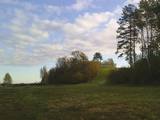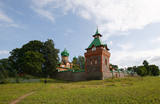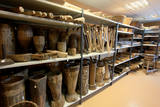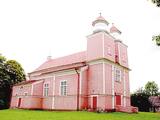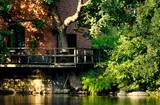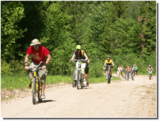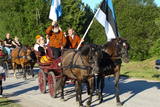| Nr | Name | Beschreibung |
|---|---|---|
|
The Velēna Lutheran Church is at the crossing of the Smiltene-Gulbene-Lizums roads. It is said that the roof of the first wooden church at this location had a peat moss roof. The organ from the Sauer company still works, and it is one of the best organs in Latvia. The organist offers guided tours of the church. |
||
|
Mit heutigen Augen gesehen, scheint es unglaublich, dass noch vor etwa zwanzig Jahren an der Meeresküste speziell gebaute Gebäude mit beeindruckende Scheinwerfer gelegen waren. In der dunkle Zeit des Tages wurden die Scheinwerfer auf besondere Schienen auf die Platformen geschiebt, damit sie das Meeresaquatorium und Strand ausleuchten und die potentiellen Grenzverletzer aufweisen. Aus dem oben erwähneten Objekt sind nur die gebäude und daneben liegenden Gemäuer der Platforme erhalten geblieben, doch auch diese sind von den Meereswellen zerstört worden.
|
||
|
Atrodas Zebrus ezera austrumu krastā pie Latvijas Valsts mežu laivu bāzes. No torņa labi pārskatāms Zebrus ezers, ziemeļu virzienā – Ezerlūķu pilskalns. Laivu bāzē – atpūtas vietas. |
||
|
This tree, too, was supposedly planted by the king of Sweden – and upside down, no less.
|
||
|
Die Holzkirche wurde 1766 erbaut, die neue Mauerkirche wurde anstelle der alten Kirche 1868 errichtet und eingeweiht. Der hohe Turm diente während der Tageszeit als Orientierungspunkt für Schiffe. 1993 wurde das Altarbild der Künstlerin Gunta Liepiņa-Grīva „Christus und Petrus auf dem Meer“ eingeweiht, das anstelle des verlorenen Gemäldes gemalt wurde. Am 18. November 1923 wurde im nebenliegenden Pfarrhaus von Mazirbe (heute das Zentrum für Rekollektion) die blau-grün-weiße livische Flagge eingeweiht. In der Umgebung des Pfarrhauses kann man Messsteine von Mazirbe, Zeugen des Schwarzen Todes (1710, 1711), finden. Der lateinische Text auf den Steinen deutete, dass die Liven des Küstengebietes durch Karl IX. und Pest überwältigt wurden. Der Text auf den Steinen ist nicht mehr lesbar, wurde jedoch entschlüsselt und ist bekannt. Auf dem Friedhof von Mazirbe ist das Denkmal des Alten Taizelis, ein Denkmal für die Eltern des Kapitäns A. Bertholds und die Grabstätte des legendären Werwolfs, zu sehen. |
||
|
Ģimenes uzņēmumā “Burka un ledus” audzē un pārstrādā asos piparus. Apmeklētājiem piedāvā degustācijas un ekskursiju pa ražotni. |
||
|
Die Hauptstadt Litauens. Eine der größten Altstädte Osteuropas, ist in die UNESCO Liste des Weltkulturerbes aufgenommen worden. In der Altstadt sind verschiedene architektonische Stile dargestellt: Klassizismus, Barock, Gotik, Renaissance u.a. |
||
|
Das Café befindet sich in der Nähe der evangelisch lutherischen Kirche von Talsi. Lettische Küche: Bohnensuppe, Ampfersuppe, kalte Suppe, Graupengrütze, Erbsenbrei, Gerstengrütze, geschmortes Gemüse, geschmortes Fleisch, hausgemachte Frikadellen, graue Erbsen mit Speck, Schweinerippen, Kartoffelpfannkuchen, Himmelsbrei, Kompott mit Milch. |
||
|
Der Garten liegt am Ufer des Flusses Gauja in Nähe der Burgruine von Valmiera. Erzählung über die Verwendung von Pflanzen beim Kochen. Programme zum Brot-, Lebkuchenbacken, Käsezubereitung. |
||
|
This farm produces raspberries (6 ha), herbs, medicinal plants (more than 100 types), vegetables (red peppers, cucumbers, tomatoes, chili peppers, onions, garlic) and bees. The owner produces salads, jams, lecho and chutneys. You can purchase vegetable products, pick your own raspberries and strawberries, taste teas, buy honey, and receive valuable consultations. |
||
|
Smārdes krogs (Wirtshaus von Smārde)
befindet sich an dem historischen Platz des alten
Wirtshauses mit Möglichkeit einen Happen zu essen.
Ungefähr 1 00 m nach Osten befindet sich der
Brüderfriedhof und Denkmal an die im Zweiten
Weltkrieg gefallenen Soldaten.
|
||
|
Īdeņa Castle mound is located near Lake Lubāns. A beautiful view
to the lake and to the marshy meadows. The place was inhabited from
the 11th century.
|
||
|
Kloster von Kuremäe wurde im Jahr 1891 errichtet und es ist das einzige tätige russisch-orthodoxe Nonnenkloster in Estland. In den vergangenen Tagen befand sich hier der Hainort der altertümlichen Esten. Am Berg ist eine Opferquelle, die heute wegen seines heilenden Wassers als heilige Quelle genannt wird. Kloster ist für die Touristen geöffnet und alltägliches Leben der Klosterbewohner kann man besichtigen. Wer den ganzen Klosterkomplex besichtigen möchte, kann von Nonnen eine Führung bestellen. |
||
|
Ethnographic and household storage in Sarkaņi offers craft tools collection, furniture and household collection, 19th and the end of the 20th century living room furnishings, and the exhibition dedicated to Madona countrymen. (Source: Madona TIC) |
||
|
Befindet sich im Südteil der Siedlung Feimaņi. Die Kirche wurde von 1756 bis 1760 gebaut. Feimaņi war ein Eigentum der Baronengeschlecht von Korff. Die Kirche gehörte verschiedenen Konfessionen gemäß dem Religionswechsel der Baronen von Korff vom Luthertum zum Katholizismus. Es lohnt sich zu erwähnen, dass die katholische Kirche in Feimaņi sich zwischen den Kirchen im Bezirk Rēzekne durch größte Anzahl der Kunstdenkmäler von staatlicher Bedeutung auszeichnet. Darunter sind eine Beichtbank, Kirchenbänke, einen Orgelprospekt, Silberbecher und fünfzehn Holzschnitzereien des Altars, darunter drei aus dem 18. Jahrhundert zu erwähnen. Bei den Kirchentoren erhebt sich einen Glockenturm mit vier Glocken. Während der Karwoche werden in der Kirche anstatt der Glocken die s.g. “Klappern” verwendet. Die sind 2 m lange un1 m hohe Gegenstände, die an altertümliche Wäschemängel erinnern. In Feimaņi befindet sich eine der drei Fahnenherstellungswerkstätten Lettlands, die mit den modernsten Einrichtungen im Baltikum ausgestattet ist. An diesem Ort wurde sowohl ideologisch als auch physikalisch die Fahne Lettgallens “geboren”. |
||
|
Svartå Manor is one of the most precious manor houses in Finland with a history of more than two hundred years. The countryside hotel consists of five different historical buildings situated in an idyllic park with a scenic river flowing nearby. Near the manor is a restaurant and a museum, where you can take a tour. |
||
|
Das Gotteshaus ist im Jahr 1895 gebaut, aber im Jahr 1906 umgebaut worden. Auf seinem Turm befinden sich drei Glocken, die aus Silber und Kupfer gegossen sind und von denen eine zu der größten Glocke (4832 kg) in den baltischen Staaten ernannt worden ist. Neben dem Gottsehaus befindet sich ein Museum, das mit der Kultur und dem Kirchenleben der Altgläubigen bekannt macht. Dieser Ort ist einer der seltenen Orte der Altgläubigen, der öffentlich zugänglich ist. |
||
|
Alltägliches Leben und Bauernarbeit, Schaffarm mit tollen estnischen Schwarzkopfschafe. Auf altertümlichen Kulturpfad (Steingräber, Felder, Heide) erfahren sie mehr von den altertümlichen Esten und Geschichte des Bauernhofes. Am Hof beschäftigt man sich mit Handarbeit, auch die Gäste haben die Möglichkeit etwas aus Wolle zu basteln. |
||
|
Lustužkalns – auf dem hohen Hügel (72
müdM) befand sich im 16 Jh. das Jagdschloss
vom Heermeister des Ordens von Livland
Wolter von Plettenberg. Aber in der Zeit der
russischen Kaiserin Katharina wurde hier ein
Vergnügungsschloss errichtet. Daher kommt
auch der Name vom Schloss und die
Erzählung der im Valguma See versenkten
goldenen Kutsche.
|
||
|
Reiterhof Tihuse bietet Reiten (von der Kutschefahrt bis zu Ausritte) und Beherbergung an. |
||

